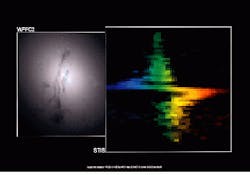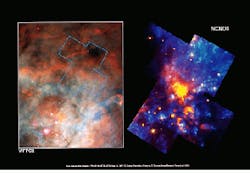The recently installed Space Telescope Imaging Spectrograph (STIS) inside the Hubble Space Telescope is proving that it is relatively simple to see a black hole in a galaxy, even one that is 50 million light-years from Earth (see Laser Focus World, May 1997, p. 17). The colorful zigzag on the right of the image below is the signature of a large black hole in the center of galaxy M84, discovered by the new STIS. The left part of the image taken in visible light with Hubble`s Wide Field Planetary and Camera 2 (WFPC2) shows the core of the galaxy where it is believed a black hole exists.
Within 20 minutes, astronomers mapped the motions of gas in the grip of the black hole`s powerful gravitational pull by aligning the STIS spectroscopic slit across the nucleus in a single exposure. The STIS data indicate the rotational motion of stars and gas along the slit. The change in wavelength records whether an object is moving toward or away from the observer. The larger the excursion from the centerline--seen as green and yellow pixels along the center strip—the greater the rotational velocity. If no black hole were present, the line would be nearly vertical across the scan.
The speed of orbiting matter at the center of the galaxy is about 400 km/s. This pushes the emission to the far ends of the spectrum into the red and far blue. At the plenary session of the Conference on Lasers and Electro-Optics in May, Peter Stockman commented that the sharp increase in speed is caused by the presence of a central black hole, at least the size of 300 million suns.
A second instrument, the Near Infrared Camera and Multi-Object Spectrometer (NICMOS), also was installed in the February repair mission. This camera penetrated the dust of the Orion Nebula to detect what astronomers are calling a star nursery (see top image on p. 40).
The image was taken with visible light from Hubble`s WFPC2. NICMOS`s infrared vision reveals a chaotic, active star-birth region. Stars and glowing interstellar dust, heated by and scattering the intense starlight, appear yellow-orange (right). Emission from excited hydrogen molecules appears blue. The diagonal extent of the image is about 0.4 light-year. The brightest object in the image is a massive young star called BN (Becklin-Neugebauer). Blue "fingers" of molecular hydrogen emission indicate the presence of violent outflows, probably produced by a young star or stars still embedded in the interstellar dust. The detection of several sets of closely spaced double stars in these observations proves the ability of NICMOS to see fine details not possible to see from ground-based telescopes.
NICMOS has also managed to capture the last gasps of a dying star. The Egg Nebula, also known as CRL 2688, is located 3000 light-years away in the constellation Cygnus (see bottom images). Again, the image on the left was taken in visible light with the WFPC2. At this point, the nebula is nothing more than an expanding cloud of gas and dust ejected by a dying Sun-like star that has burned most of its fuel.Studying the death of Sun-like stars is important for understanding how two of the elements crucial for human life--carbon and nitrogen, formed from hydrogen and helium inside stars—are expelled into the interstellar medium. Eventually, these elements become the building blocks of new stars and planets.
The newest images captured by Hubble`s "new eyes" can be seen on the Web at http://oposite.stsci.gifdu.
About the Author
Laurie Ann Peach
Assistant Editor, Technology
Laurie Ann Peach was Assistant Editor, Technology at Laser Focus World.

